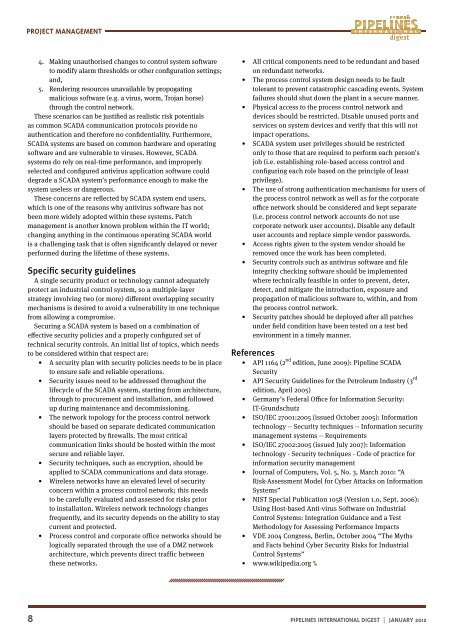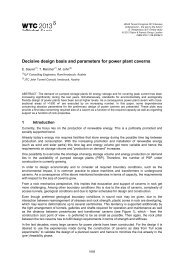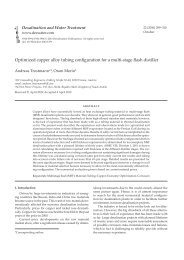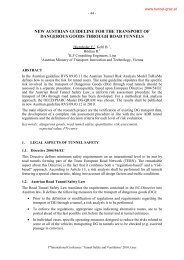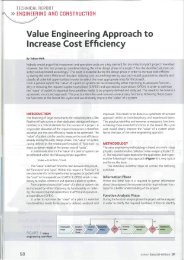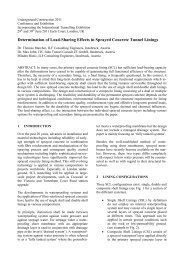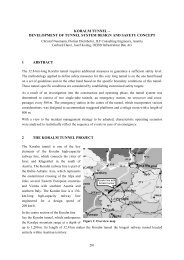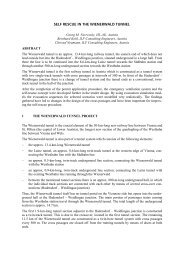Cyber-attack protection for pipeline SCADA systems - ILF Consulting ...
Cyber-attack protection for pipeline SCADA systems - ILF Consulting ...
Cyber-attack protection for pipeline SCADA systems - ILF Consulting ...
Create successful ePaper yourself
Turn your PDF publications into a flip-book with our unique Google optimized e-Paper software.
ProJect management<br />
4. Making unauthorised changes to control system software<br />
to modify alarm thresholds or other configuration settings;<br />
and,<br />
5. Rendering resources unavailable by propogating<br />
malicious software (e.g. a virus, worm, Trojan horse)<br />
through the control network.<br />
These scenarios can be justified as realistic risk potentials<br />
as common <strong>SCADA</strong> communication protocols provide no<br />
authentication and there<strong>for</strong>e no confidentiality. Furthermore,<br />
<strong>SCADA</strong> <strong>systems</strong> are based on common hardware and operating<br />
software and are vulnerable to viruses. However, <strong>SCADA</strong><br />
<strong>systems</strong> do rely on real-time per<strong>for</strong>mance, and improperly<br />
selected and configured antivirus application software could<br />
degrade a <strong>SCADA</strong> system’s per<strong>for</strong>mance enough to make the<br />
system useless or dangerous.<br />
These concerns are reflected by <strong>SCADA</strong> system end users,<br />
which is one of the reasons why antivirus software has not<br />
been more widely adopted within these <strong>systems</strong>. Patch<br />
management is another known problem within the IT world;<br />
changing anything in the continuous operating <strong>SCADA</strong> world<br />
is a challenging task that is often significantly delayed or never<br />
per<strong>for</strong>med during the lifetime of these <strong>systems</strong>.<br />
Specific security guidelines<br />
A single security product or technology cannot adequately<br />
protect an industrial control system, so a multiple-layer<br />
strategy involving two (or more) different overlapping security<br />
mechanisms is desired to avoid a vulnerability in one technique<br />
from allowing a compromise.<br />
Securing a <strong>SCADA</strong> system is based on a combination of<br />
effective security policies and a properly configured set of<br />
technical security controls. An initial list of topics, which needs<br />
to be considered within that respect are:<br />
• A security plan with security policies needs to be in place<br />
to ensure safe and reliable operations.<br />
• Security issues need to be addressed throughout the<br />
lifecycle of the <strong>SCADA</strong> system, starting from architecture,<br />
through to procurement and installation, and followed<br />
up during maintenance and decommissioning.<br />
• The network topology <strong>for</strong> the process control network<br />
should be based on separate dedicated communication<br />
layers protected by firewalls. The most critical<br />
communication links should be hosted within the most<br />
secure and reliable layer.<br />
• Security techniques, such as encryption, should be<br />
applied to <strong>SCADA</strong> communications and data storage.<br />
• Wireless networks have an elevated level of security<br />
concern within a process control network; this needs<br />
to be carefully evaluated and assessed <strong>for</strong> risks prior<br />
to installation. Wireless network technology changes<br />
frequently, and its security depends on the ability to stay<br />
current and protected.<br />
• Process control and corporate office networks should be<br />
logically separated through the use of a DMZ network<br />
architecture, which prevents direct traffic between<br />
these networks.<br />
• All critical components need to be redundant and based<br />
on redundant networks.<br />
• The process control system design needs to be fault<br />
tolerant to prevent catastrophic cascading events. System<br />
failures should shut down the plant in a secure manner.<br />
• Physical access to the process control network and<br />
devices should be restricted. Disable unused ports and<br />
services on system devices and verify that this will not<br />
impact operations.<br />
• <strong>SCADA</strong> system user privileges should be restricted<br />
only to those that are required to per<strong>for</strong>m each person’s<br />
job (i.e. establishing role-based access control and<br />
configuring each role based on the principle of least<br />
privilege).<br />
• The use of strong authentication mechanisms <strong>for</strong> users of<br />
the process control network as well as <strong>for</strong> the corporate<br />
office network should be considered and kept separate<br />
(i.e. process control network accounts do not use<br />
corporate network user accounts). Disable any default<br />
user accounts and replace simple vendor passwords.<br />
• Access rights given to the system vendor should be<br />
removed once the work has been completed.<br />
• Security controls such as antivirus software and file<br />
integrity checking software should be implemented<br />
where technically feasible in order to prevent, deter,<br />
detect, and mitigate the introduction, exposure and<br />
propagation of malicious software to, within, and from<br />
the process control network.<br />
• Security patches should be deployed after all patches<br />
under field condition have been tested on a test bed<br />
environment in a timely manner.<br />
References<br />
• API 1164 (2 nd edition, June 2009): Pipeline <strong>SCADA</strong><br />
Security<br />
• API Security Guidelines <strong>for</strong> the Petroleum Industry (3 rd<br />
edition, April 2005)<br />
• Germany’s Federal Office <strong>for</strong> In<strong>for</strong>mation Security:<br />
IT-Grundschutz<br />
• ISO/IEC 27001:2005 (issued October 2005): In<strong>for</strong>mation<br />
technology -- Security techniques -- In<strong>for</strong>mation security<br />
management <strong>systems</strong> -- Requirements<br />
• ISO/IEC 27002:2005 (issued July 2007): In<strong>for</strong>mation<br />
technology - Security techniques - Code of practice <strong>for</strong><br />
in<strong>for</strong>mation security management<br />
• Journal of Computers, Vol. 5, No. 3, March 2010: “A<br />
Risk-Assessment Model <strong>for</strong> <strong>Cyber</strong> Attacks on In<strong>for</strong>mation<br />
Systems”<br />
• NIST Special Publication 1058 (Version 1.0, Sept. 2006):<br />
Using Host-based Anti-virus Software on Industrial<br />
Control Systems: Integration Guidance and a Test<br />
Methodology <strong>for</strong> Assessing Per<strong>for</strong>mance Impacts<br />
• VDE 2004 Congress, Berlin, October 2004 “The Myths<br />
and Facts behind <strong>Cyber</strong> Security Risks <strong>for</strong> Industrial<br />
Control Systems”<br />
• www.wikipedia.org<br />
8 PiPelines international digest | JanUarY 2012


